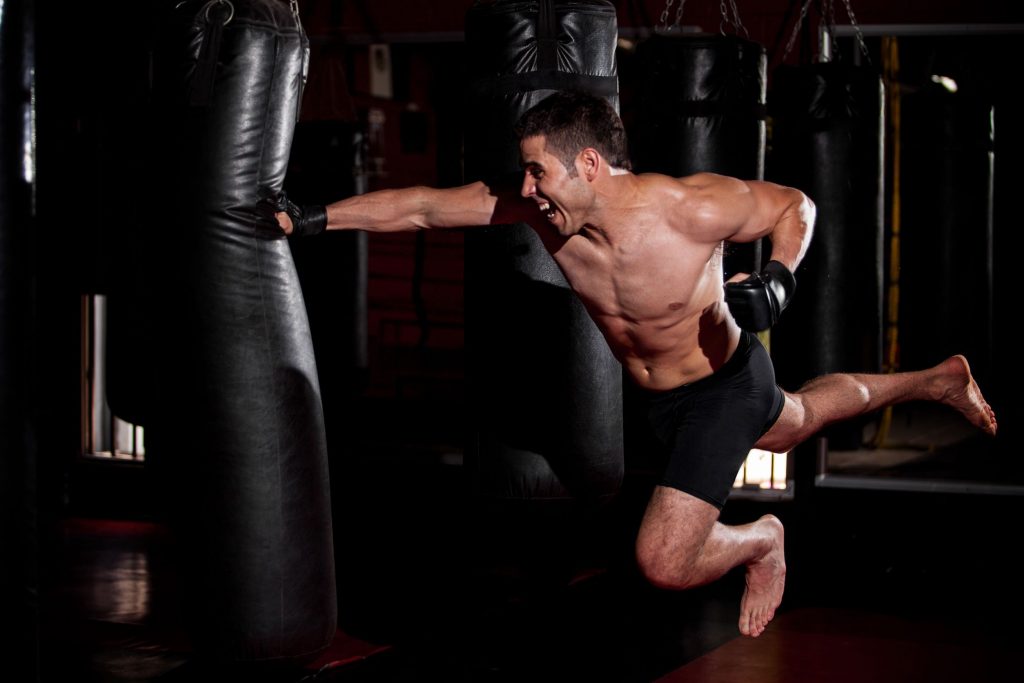Got a cool exercise for you today: the Serratus Punch.

NOTE: Actual exercise not pictured. More power to you if you want to pull it off though. I mean, it does work the serratus…;O)
But First – A Rookie Parenting Mistake
It was a consortium of errors this past weekend. Lisa and I were supposed to head to Toronto for our Strong Body-Strong Mind workshop.
We were pumped to go, but what made the trip an even bigger of a deal was the fact it was going to be our first attempt at bringing our almost 5-month old, Julian, with us. On a plane. Did I mention on a plane?
On a plane.
With no where to go if he acted up.
You could say we were both a little nervous. But we took solace in that the plane ride from Boston to Toronto is a pretty short one and we had a kick-ass weekend a head of us hanging out with 25+ fitness professionals.
That is until we got to the airport, through security waiting at our gate, and were then informed Julian needed a passport.
Whaaaaaaaaaaaaaaaat?1
In the end we had to postpone our workshop, and head back home with our tail between our legs.
Sorry Toronto. We’ll see you later this year, I promise. The man can’t keep us down.
We have a tentative date planned in September, but will confirm shortly.
Lets get to the exercise….
Serratus Punch
Who Did I Steal It From: This is an exercise I’ve done for several years with clients off the floor. The addition of the stability ball, though, is something I snaked from Dr. Joel Seedman.
What Does It Do: The serratus anterior is the muscle located alongside the ribcage and plays a crucial role in shoulder health and performance. Specifically, it’s main role is to aid in upward rotation of the scapulae via protraction.2
It’s a relatively innocuous muscle, but I’d venture a guess the bulk of shoulder “issues” you come across as a personal trainer or strength coach can be remedied with a little more TLC given to it.
It’s a BIG deal.
It’s a big deal especially when we start discussing one’s ability to raise his or her’s arms overhead. In order to do so, safely, three actions need to happen with the shoulder blades:
- Upward rotation
- Posterior tilt
- Protraction
I feel protraction is a lost movement. More and more we’re finding people “stuck” in an extension pattern which has a domino effect up and down the kinetic chain. With regards to upper extremity movement and mechanics we find people with a more depressed (low, not sad) shoulder girdle, excessive rib flair, and shoulder blades that tend to be more adducted/retracted and downwardly rotated.
In no small part the culprit can often be pointed to execution of common strength training movements. True, in order to lift BIG weight with the “big 3” it behooves anyone to “pack” the shoulder blades together and down when setting up to bench press, deadlift, or squat.
Getting and maintaining full-body tension requires “stuff” to be locked down tight.
That being said, it’s still important to be able to access movement. While we may coach people to clamp their shoulder blades down when bench pressing, as an example, to provide more stability to the joint, that doesn’t mean this should be the case 100% of the time.
Protraction or reaching is a vital component for shoulder health and performance.
And the serratus anterior is an often neglected muscle that can have profound effects on how one’s shoulder feels.
Also, not for nothing, this is also a solid core stability exercise.
Key Coaching Cues: Since the successful execution of this exercise is predicated on one’s ability to perform a plank position that doesn’t make me want to throw up a little, lets discuss that first:
- TENSION! – everything should be firing. Your abs, your glutes, your quadricep muscle, your eyeballs, everything.
- You should not be “hanging out” on your lower back.
Once you’ve got that down, from there the idea is to “punch” or push away from the stability ball making sure to stay fully engaged throughout.
NOTE: I’d start with performing these off a more solid surface – like the floor – if you’re new to this.
I like to add a full exhale as I push away which will help with keeping the ribs down (and serve as a kick-ass ab workout).
Under control, lower yourself back down by retracting the shoulder blades making sure not to poke your head forward. You should still be engaged here.
Don’t relax.
Repeat for a total of 8-12 repetitions.
- All we brought with us was his Birth Certificate, which, in fairness, is what Lisa researched we had to bring with us, and the person at Air Canada told us to bring (I.e., some form of proof of identity). Unfortunately, we were wrong.
- The serratus also helps keep the shoulder blade more congruent or “snug” up against the ribcage/thorax. Maybe even more important is that it also helps increase hugging capability by 117%. Science.


